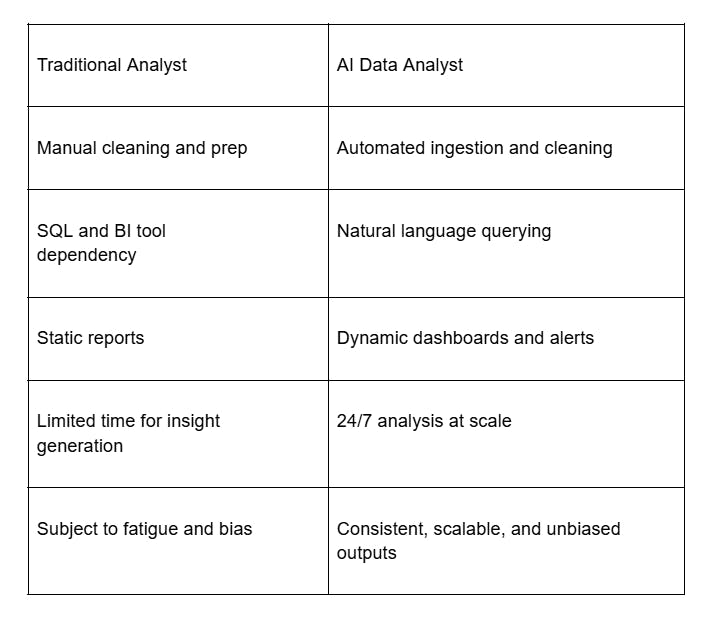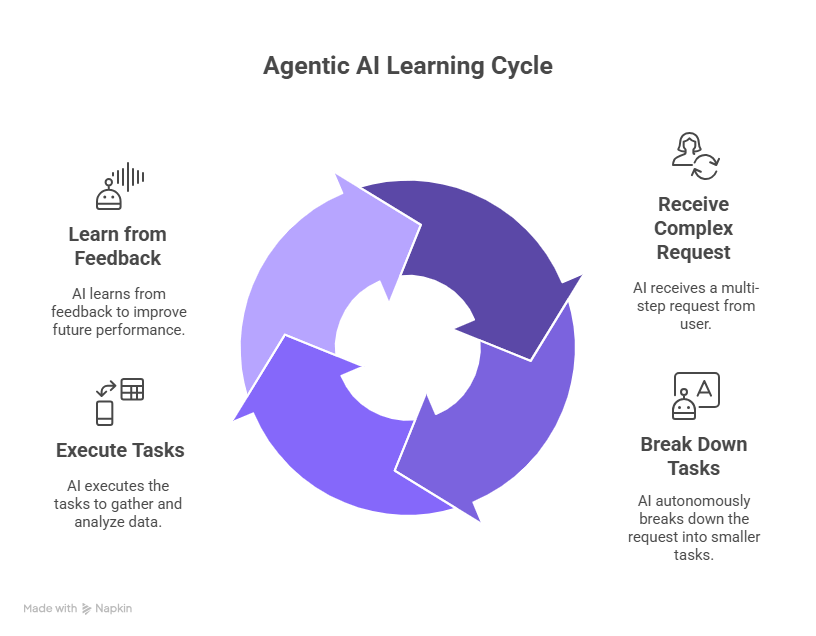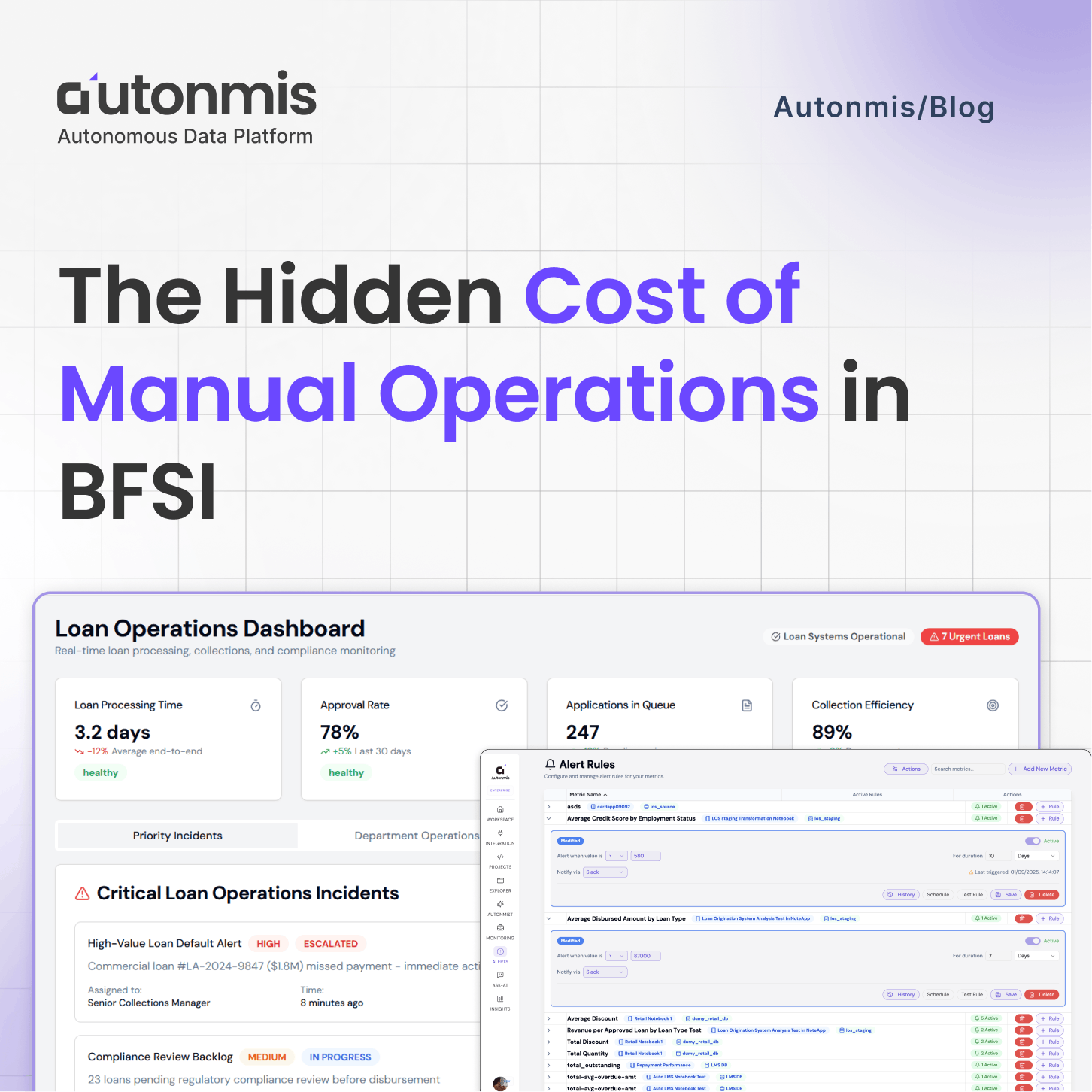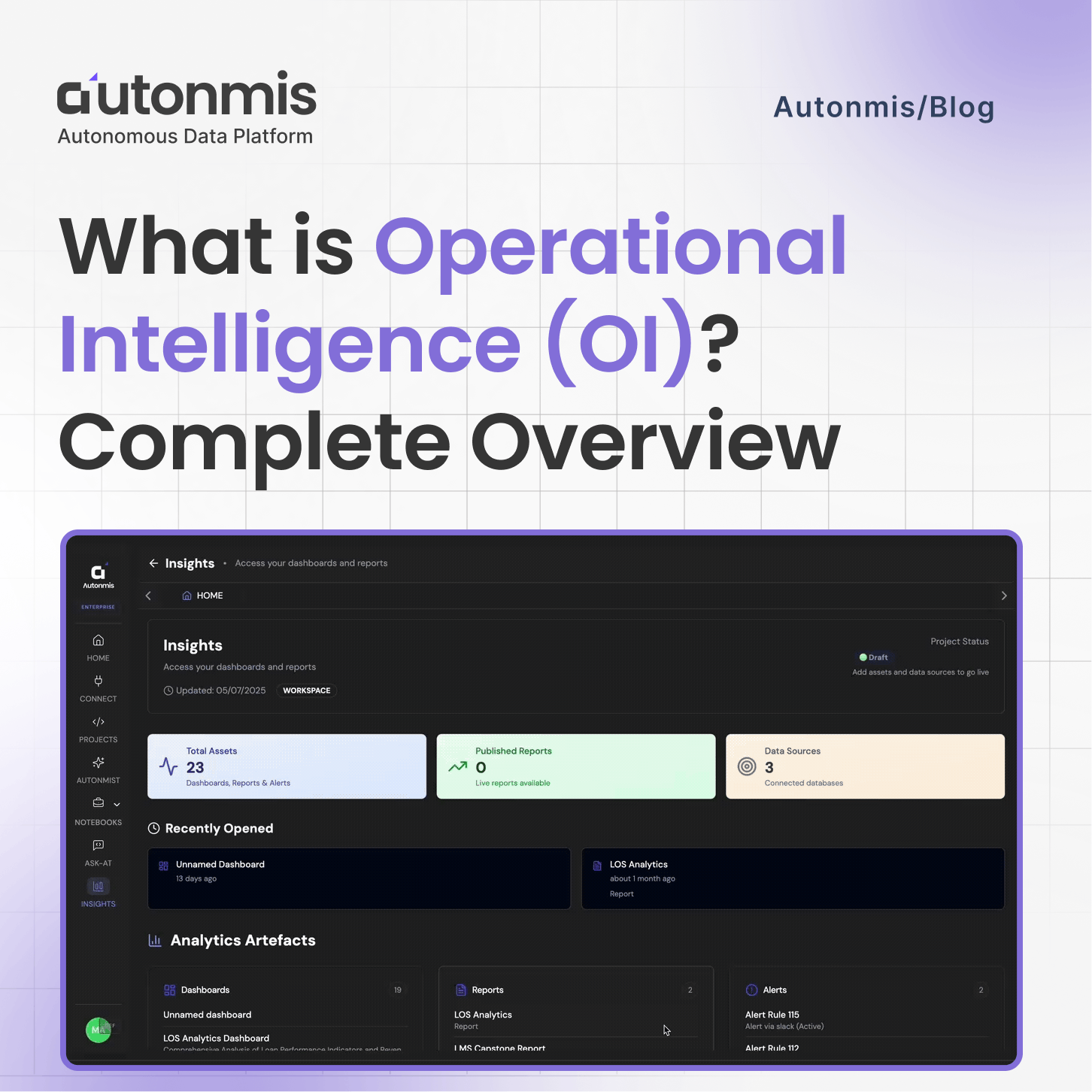2/22/2025

AB
What Is an AI Data Analyst? A Practical Guide for Modern Data Teams
An AI Data Analyst is not a job title but an intelligent system that automates data ingestion, analysis, and reporting using AI, ML, and NLP - turning raw data into actionable insights with minimal human effort. By augmenting human analysts and enabling real-time, scalable analytics, these systems help modern teams shift from manual reporting to strategic decision-making at speed.

"Your team just spent 40 hours cleaning data and preparing a report that got glanced at for 5 minutes. Sound familiar?"
If you're in data or analytics, this isn't just a bad week - it’s your norm. The demand for fast, accurate, and meaningful insights is growing, and traditional methods just can’t keep up.
So here’s the real question: How do you scale insights without scaling burnout?
This is where the concept of the AI Data Analyst comes in - not a job title, but a growing class of intelligent systems designed to handle the heavy lifting in analytics workflows.
What Is an AI Data Analyst (Really)?
Let's clear the air: an "AI Data Analyst" isn't typically a single person you'll hire tomorrow. Instead, it refers to a sophisticated system or platform powered by a combination of Artificial Intelligence (AI), Machine Learning (ML), Natural Language Processing (NLP), and Generative AI (GenAI).
Think of it as:
- A co-pilot for your analytics team
- A system that can read raw data, find patterns, generate insights, and even build dashboards with little to no human input
Here’s what these systems are designed to handle:
- Automated Data Ingestion & Preparation: Connecting to your messy, diverse data sources (CRMs, ERPs, marketing platforms, databases), then autonomously cleaning, transforming, and structuring data with minimal human oversight. This slashes your data prep time from days to minutes.
- Exploratory Data Analysis (EDA) on Steroids: Instead of manually plotting charts, the AI Data Analyst automatically identifies patterns, anomalies, correlations, and distributions across your entire dataset, surfacing hidden relationships you might miss.
- Proactive Insight Generation: Ever wish your data would just tell you what's important? These systems proactively surface significant findings and emerging trends, acting like an early warning system for your business.
- Predictive & Prescriptive Analytics: Moving beyond "what happened" to "what will happen" and "what should we do." Building models to forecast future outcomes and recommending optimal actions (e.g., "reduce churn by targeting Segment X with Offer Y").
- Natural Language Querying (NLQ) & Dynamic Reporting: Imagine asking your data, in plain English, "What were the key drivers of customer churn in EMEA last quarter?" and getting not just numbers, but a narrative summary, visualizations, and actionable recommendations.
- Automated Dashboarding & Visualization: Dynamically creating relevant, context-aware dashboards and visualizations, updated in real-time, eliminating manual report generation.
Core Value Proposition: AI Data Analysts aim to democratize data insights across your organization and dramatically accelerate time-to-value from your data investments. Platforms like Autonmis are pioneering this with concepts like the Autonomous Data Workspace, where these AI capabilities converge for a more fluid and intelligent data interaction.

Checkout: What Is the Modern Data Stack and How Does It Work in 2025?
Why Now? The Perfect Storm for AI in Analytics
This isn't just a shiny new tech fad. Several converging factors are driving the urgent need for AI Data Analysts:
- The Unprecedented Data Deluge:
- Problem: The sheer volume, velocity, and variety (3Vs) of data being generated today is overwhelming traditional analytical methods. Manual processes simply can't keep up.
- AI Solution: AI scales infinitely, processing petabytes of data faster and more accurately than any human team.
- Breakthroughs in AI/ML:
- Problem: Previous AI was limited.
- AI Solution: Recent advancements in deep learning, especially Large Language Models (LLMs) and Generative AI, have made these sophisticated analytical capabilities not just possible, but increasingly practical and accessible for business use cases. Google Cloud, for instance, emphasizes embedding AI throughout the data lifecycle.
- The Insatiable Need for Speed & Agility:
- Problem: Market changes and customer needs are dynamic. Businesses need insights in real-time to react and gain a competitive edge.
- AI Solution: AI delivers insights in minutes, not days or weeks.
- The Persistent Data Talent Gap:
- Problem: Skilled data scientists and analysts are in high demand and short supply. Finding and retaining top talent is a major challenge.
- AI Solution: AI helps bridge this gap by automating routine, time-consuming tasks, allowing your existing team to focus on higher-value work.
- The Push for Data Democratization:
- Problem: Data insights are often siloed within specialized teams, limiting wider business impact.
- AI Solution: A growing desire to empower more business users - not just data experts – with data-driven decision-making capabilities, without requiring them to become coding gurus.
How Is It Different From Traditional Analytics?

Big Idea: The AI Data Analyst doesn’t replace humans. It handles the grunt work, so human analysts can focus on judgment, communication, and innovation.
Checkout: How Agentic AI Powers Autonomous Data Workspace 2025
The "Less Known" Advantage: Leveraging Agentic AI in Analytics
You've heard of automation. You've heard of insights. But the true game-changer coming down the pipe, and what we're building at Autonmis, is Agentic AI.
- What it is: This isn't just about AI doing tasks. It's about AI systems (or "agents") that can understand complex, multi-step requests, autonomously break them down into smaller tasks, execute those tasks, and crucially, learn from feedback to improve future performance.
- Why it matters (Your Edge): This moves beyond simple automation to genuine intelligent assistance. Imagine asking your data platform: "What were the key drivers of churn last quarter in the EMEA region, and what are three actionable strategies to mitigate it, considering our current marketing spend?" – and getting a comprehensive, data-backed answer, not just a dashboard. This type of nuanced, proactive response is where the real competitive advantage lies. It's about anticipating needs and suggesting solutions before you even know to ask.
- The AI Analyst's Role: Acts as an intelligent collaborator, capable of complex reasoning and proactive analysis, often integrating information from disparate systems (e.g., pulling sales data, marketing campaign performance, and customer support tickets to give you a holistic churn mitigation strategy).

What Does This Means for You?
The rise of the AI Data Analyst isn't a threat to your job; it's a massive opportunity to elevate your strategic impact. For executives, PMs, and data leads, this means:
- Strategic Focus Shift: Your teams can finally move away from time-consuming data wrangling and routine report generation. They can now dedicate valuable time to hypothesis formulation, complex problem-solving, identifying new market opportunities, and driving data literacy across the organization.
- Faster, Deeper Insights: Access more sophisticated analysis without proportionally increasing headcount or enduring lengthy, expensive project cycles. Get answers in hours, not weeks.
- Enhanced Decision-Making: Decisions at all levels - from sales strategies to product development – can be more consistently informed by comprehensive, up-to-the-minute data analysis, moving beyond gut feelings or limited datasets.
- Innovation Acceleration: By automating the known, you free up resources to explore the unknown. This fosters a culture of data-driven innovation, allowing you to quickly identify customer behavior patterns for new product features or discover untapped revenue streams.
Insight - Here’s a critical point many overlook: as AI Data Analysts start uncovering a flood of potential insights, the real skill for your team will be sifting through them. Think about it – AI can find thousands of patterns. The new challenge isn't just finding insights, but figuring out which ones truly matter to the business. Your team's value will skyrocket if they can pick out those golden nuggets from all the noise, explain why they're important, and help turn them into smart business moves.
Consider this: What strategic questions could you finally answer if your team had that newfound bandwidth? What new product features could you develop based on rapidly identified customer behavior patterns that are currently hidden in your data?
Is Your Organization Ready for an AI Data Analyst? A Quick Self-Assessment
Before jumping in, ask these crucial questions to gauge your readiness:
- Data Maturity: Is your data somewhat centralized, or is it scattered across dozens of disconnected systems? (While AI can help with integration, a baseline level of organization helps.)
- Current Pain Points: Are your human analysts constantly swamped with repetitive tasks? Is there a backlog of critical analysis projects?
- Leadership Buy-in: Does executive leadership understand the potential of AI to drive business value, beyond just cost savings?
- Skills Evolution: Is your team open to learning how to collaborate with AI tools, rather than just using traditional methods? (This isn't replacement; it's augmentation.)
- Integration Needs: Do you need a solution that plays well with your existing tech stack (CRMs, BI tools, etc.)?
Core Insight: The biggest hurdle isn't the tech itself, but organizational readiness and the willingness to rethink workflows.
Checkout: Top 5 Autonomous Data Platforms: Leading the Charge in 2025
The Future is Autonomous, Intelligent, and Collaborative
The journey towards fully realizing the potential of AI Data Analysts is still unfolding, but the trajectory is clear: data analytics will become more intelligent, more automated, and increasingly autonomous. Platforms like Autonmis are at the forefront of this evolution, focusing on building Autonomous Data Workspaces where these capabilities converge.
Insight - And looking even further ahead, something truly groundbreaking is that these AI systems won't just do the analysis; they'll get smarter about how analysis is done in your organization. Imagine an AI that learns which types of investigations give your team the best results, spots bottlenecks in how you get from data to decisions, and even suggests ways to make your whole analytical process faster and more impactful over time. It’s like having an AI consultant constantly helping you fine-tune your entire data strategy.
The key isn't just about picking powerful AI capabilities. It's about choosing solutions that:
- Integrate seamlessly into your existing workflows.
- Truly empower your existing teams, making them more effective.
- Align directly with your core business objectives, delivering tangible ROI.
Ready to explore how an AI Data Analyst can transform your data strategy? Visit Autonmis.com to learn more about our Autonomous Data Workspace and start freeing your team to focus on what truly matters.
Recommended Learning Articles

9/22/2025

AB
The Hidden Cost of Manual Operations in BFSI

8/16/2025

AB
What is Operational Intelligence (OI)? Complete 2025 Overview
Data stack for operational excellence
Autonmis helps modern teams own their entire operations and data workflow — fast, simple, and cost-effective.